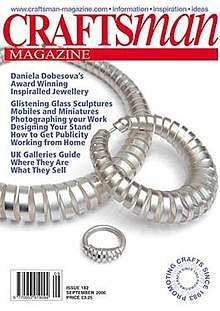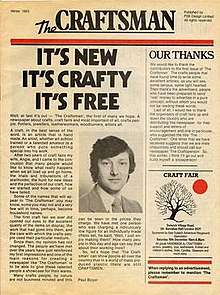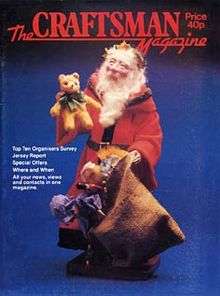Craftsman Magazine
For almost 25 years, since its launch in 1983 until June 2007, Craftsman Magazine was the main UK publication for professional craftspeople and hobbyists wanting to sell their work. With a focus primarily on selling through Craft Fairs and Trade Fairs in Britain, the magazine developed alongside the UK craft industry and became an important resource for people wanting to earn a living from their work.

The publishers, Angie and Paul Boyer, Directors of PSB Design & Print Consultants Limited, first realised there was a need for such a publication when they were selling their own work at UK Craft Fairs in the early 1980s; there was nothing available at that time to inform people about the craft fairs, who organised them, where and when they were taking place or how to book stands at events.
As the UK Craft industry expanded and developed over the years, the publishers realised that the profile of the magazine needed to change as well, so in the summer of 2007 they relaunched the publication as Craftsman craft&design Magazine with a new format, new design and a more contemporary approach to the content. The aims remain the same, to help craftspeople in Britain to earn a living from their work.
Development and History

The first issue of Craftsman Magazine was published Winter 1983 by Paul and Angie Boyer, Directors of PSB Design and Print Consultants Limited, a small graphic design business based in Commercial Street, London E1. The first issue was 16 pages, printed in 2 colours onto newsprint and 30,000 copies were circulated free of charge at craft fairs all over Britain. The editorial in the first issue featured Bookbinding, Batik, Jewellery, Leather Carving and Craft Fairs. The aim of the magazine was to put craft people in touch with each other, to inform craft makers and buyers about where and when craft fairs were being held, and to provide information about who organised craft fairs in Britain and how to book a stand at the fairs. Advertising was mainly from craft fair organisers.
Husband and wife team, Paul and Angie Boyer continued to publish Craftsman Magazine 4 times a year from their London address until 1985 when, with issue number 5, they moved to Littlehampton in Sussex. By that time an annual subscription had been made available, editorial content had been expanded to include Business Advice for craft people and advertising had grown to reflect the growth in the number of craft fairs being held all over Britain. Events being advertised were at venues such as Stately Homes, Town and Village Halls, Wildlife Parks, Schools and Colleges, Hotels, Racecourses, Concert Halls, Community Centres, National Trust Properties, Leisure Centres, Sports Halls, Exhibition Centres, Shopping Centres, Airports and even US military Bases in the UK. Specialist Miniatures shows were also being advertised.
The first glossy 2 colour cover appeared on Issue number 10 of Craftsman Magazine in Spring 1986, with the number of pages increased to 36 and a cover price of 20p. The first glossy four colour cover on Issue number 13, Winter 1986, had a cover price of 40p and coincided with WH Smith agreeing to stock the magazine. The first issue to be seen on their shelves throughout Britain was Number 22, June/July 1988, by which time the magazine had increased frequency to six issues a year and was printed on glossy paper throughout.

Issue number 50 February/March 1993 marked ten years since the launch of Craftsman Magazine, which was now being produced by Angie and Paul Boyer from their address in East Yorkshire, having moved to the north of England from Sussex in 1987. This anniversary issue had a cover price of £1.70, 84 pages and colour throughout. A celebratory competition was published which gave readers the opportunity to win a hand crafted gold and diamond pendant brooch, which had been specially designed and made for the occasion by jeweller, Pam Crosland.
Craftsman Magazine changed from bi-monthly to monthly publication, producing 12 issues a year in April 1998 with Issue Number 81. It was full colour throughout, with a cover price of £2.50.
Issue 115 February 2001 of Craftsman Magazine incorporated ‘FibreAction’, a 12-page small, independent quarterly publication for textile artists and enthusiasts. Previously published and distributed by spinner and weaver, Veronica Burningham, she continued as Editor of FibreAction in Craftsman Magazine until August 2002, when the Editor changed to weaver Chris Hammacot. The last issue of Craftsman magazine to include FibreAction was August 2003.
Issue 134 September 2002 of Craftsman Magazine incorporated The Rocking Horse Magazine, the official magazine for the Guild of Rocking Horse Makers, previously an independent magazine published by rocking horse maker, Anthony Dew. Consisting of 12 pages in full colour, it was included within Craftsman Magazine annually until September 2005.
In 2002 and 2003, informative Directories were included within the pages of Craftsman Magazine; subjects included Craft Fair Organisers, Craft Supplies, Courses and Workshops, Craft Galleries, Guilds & Associations.
For almost 25 years Craftsman Magazine aimed to help and encourage craftspeople in Britain to earn a living from their creative skills. Known for its promotion of craft makers and their work, as well as the support given to trade and consumer craft fairs, in 2007 Craftsman Magazine changed significantly to expand its readership and coverage with the aim of including more about contemporary craft in Britain.
Issue 191 June 2007, with a cover price of £2.50 and 52 pages was the last to be published as Craftsman Magazine. With a new title and a new format, it was relaunched by Angie and Paul Boyer, Directors of PSB Design and Print Consultants Limited, as Craftsman craft&design Magazine. The first issue under the new title and format was July/August 2007, Issue 192. (The issue numbering continued from one format to the next).
Shows and Events
CraftAid
In 1986, Craftsman Magazine organised CraftAid, a national craft auction in aid of Save the Children. Craft people all over Britain donated work, the Craftsman offices in Littlehampton were turned into storage space for all the donated pieces, which ranged from pots by well-known ceramicists Lucie Rie, Michael Cardew and Janet Leach, through to precious metal jewellery, designer clothes, toys and teddy bears - all manner of work from both professional and hobby crafts people. Clandon Park, a National Trust Property in the South East of England, was hired as the venue for the auction, which took place over a weekend just before Christmas. People working in the craft industry donated their time to help with the auction - craft fair organisers, craft makers, friends and family. This unique event not only raised a substantial amount of money for charity, it also brought the British Craft industry together in a way that had never happened before.
National Fleece to Jumper Spinning Competition
In the same year, 1986, Craftsman Magazine organised the first National Fleece to Jumper Spinning Competition, which ran for 10 years at various craft fair venues in England, drawing supporters and participants from all over the world, including New Zealand, where the competition originated. Up to six teams, each made up of six people took part. The challenge was to knit a child's size jumper from a raw, unwashed fleece using a previously unseen pattern in the shortest possible time within a four-hour time limit. Teams started by sorting the fleece, selecting the best fibres, which were then carded, spun, plied and knitted. The final Fleece to Jumper Spinning Competition was held in 1995 at East Riddlesden Hall, Keighley, West Yorkshire, a National Trust property. It was won by the Craven Guild, who retained the title and the trophy as it was their third consecutive win. It was also the 10th year of the competition and the centenary year of the National Trust, a timely conclusion to a popular competition.
The Craftsman Magazine Fleece to Jumper Speed Record was developed from the main competition and gave individual teams the opportunity to work against the clock to a set pattern, without competing with any other teams at the same time. In 1989 the Cambridge Carders set the first record at 3 hours, 7 minutes, 5 seconds. The record was subsequently broken a number of times, but the Cambridge Carders finally reclaimed it at the Alexandra Palace Christmas Craft Fair, setting a time of 2 hours, 46 minutes, 12 seconds.
Craftmakers Materials Show
In October 1999, Craftsman Magazine organised their first Craftmakers Materials Show in London. Exhibitors were companies which supplied materials, equipment and services to craftspeople and hobbyists, plus craft guilds and associations, artists, designers and craft book publishers. Visitors could purchase art and craft supplies, watch demonstrations of art and craft techniques, take part in workshops and business advice sessions. Held annually until 2002, also in Harrogate from 2001 - 2002.
Craftsman Magazine Awards
British Craft Trade Fair Newcomer Award
In 1996, Craftsman Magazine sponsored the Newcomer Award at the British Craft Trade Fair in Harrogate, North Yorkshire, for the first time. The winner was Christine Cummings from Ormskirk in Lancashire with her Ceramic Swine sculptures. (Sponsorship of this competition continues under the magazine's new title of Craftsman craft&design Magazine).

Student Award at Art in Clay
In 1999, Craftsman Magazine sponsored the Student Award at Art in Clay (a ceramics show held at Hatfield, Hertfordshire) for the first time. It was presented in recognition of the quality of design and making of the work exhibited, the student/graduate's potential to earn a living from their work. The aim of the award was to help a young graduate to start up and run a successful business working as a potter or ceramic artist. In 1999, the award was presented to Mirka Golden-Hann for her hand thrown salt glazed pottery. Sponsored until 2007, the final Craftsman Magazine Student Award went to Kerry Williamson. Each year's winner had their work featured as a front cover article in Craftsman Magazine and were also presented with a commemorative plate specially made by Laurence McGowan.
Craftsman Award at Potfest
In 2002, Craftsman Magazine sponsored the potters’ competition at Potfest in the Pens (a ceramics show held in Penrith, Cumbria) for the first time. The concept of the competition was for exhibitors at Potfest in the Pens to make a piece to reflect a specific theme; the challenge was to use techniques different from those they usually employed in their work. With a theme of ‘Dish of the Day’ in 2002, the winner was Dennis Kilgallon of Red Dust Ceramics, whose work was subsequently the subject of a front cover feature 138 January 2003. (Sponsorship of this competition continues under the magazine's new title of Craftsman craft&design Magazine).